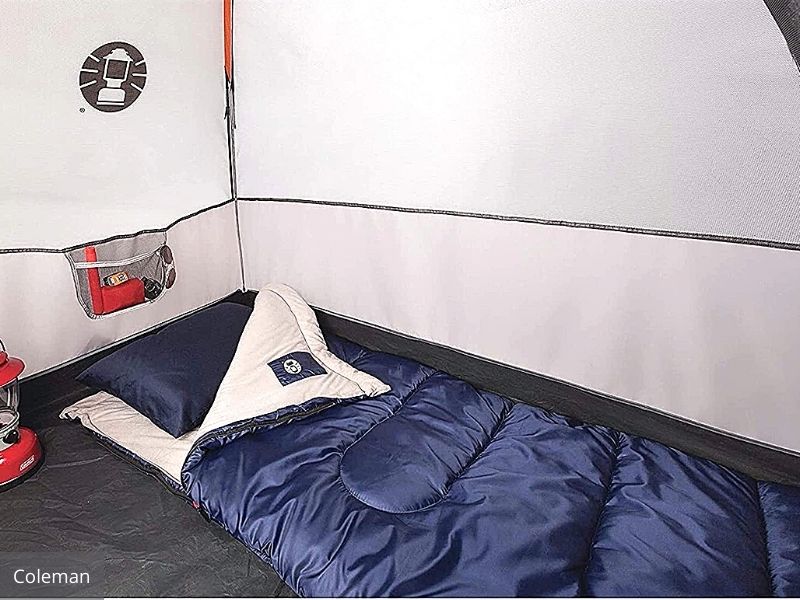Coleman sleeping bags are some of the most well-made and durable sleeping bags on the market today, which is one of the main reasons why there so popular with campers.
However, as is the case with all sleeping bags, it’s still important to properly take care of a Coleman sleeping bag, to help to prolong its useful life.
And one of the best ways to do this is to periodically wash the sleeping bag as needed.
As this will remove any smells from the bag, make the bag more comfortable for sleeping, and help to rejuvenate the insulation.
There is definitely a right way and a wrong way to wash a Coleman sleeping bag though, so in this article, we provide the 10 easy steps on how to properly clean a Coleman sleeping bag.
Plus, tips on how to take care of a Coleman sleeping bag.
Recommended Supplies and Equipment to Wash a Coleman Sleeping Bag
Before we explain the steps to wash a Coleman sleeping bag, we need to spend a few moments explaining what supplies and equipment you’ll need first.
1. Specifically Designed Outdoor Gear High-Performance Cleaner
It’s best to avoid standard laundry detergents or fabric softeners when washing a sleeping bag, as these general-purpose cleaners can actually damage the sleeping bag by stripping away the waterproofing and damaging the insulation.
So instead, you should opt for a high-performance cleaner that’s specifically designed for cleaning sleeping bags and other outdoor gear.
And one of our favorites is Nikwax Tech Wash, which can be found on Amazon.
As this cleaner is specifically designed to safely clean technical synthetic outerwear found on sleeping bags without damaging the durable water repellant as normal household detergents will.
And if you have a higher-end down sleeping bag, you should opt for Nikwax Down Wash Direct, which can also be found on Amazon.
As this high-performance cleaner is specifically designed to maintain the loft and insulating properties of down-filled items.
2. Front Load Washer
To properly wash a sleeping bag you’ll also need a front load washing machine, as top load washers have center agitators that can actually damage and even tear the often delicate fabric and stitching found on sleeping bags.
3. Large Capacity Dryer
After you’ve washed your sleeping bag, you’ll need to dry it and the best way to do this is in a large capacity clothes dryer.
As sleeping bags can be very bulky as well as heavy when they’re wet, so you want a large capacity dryer that can handle the size and weight.
4. A Couple of Clean Tennis Balls
To help fluff up the sleeping bag as it’s drying, we recommend adding a couple of clean tennis balls into the dryer.
As the tennis balls will bounce around the dryer and help to break up any clumps that might form in the sleeping bag during the drying process.
How to Wash a Coleman Sleeping Bag
Now that you know what supplies you’ll need to wash your sleeping bag, let’s move on, and jump into the steps of how to actually wash a Coleman sleeping bag.
Step 1: Check the Care Label
Before you start washing your Coleman sleeping bag, it’s always best practice to first check the care label on the sleeping bag.
And check the washing instructions to ensure that your particular Coleman sleeping bag is safe for a washer and dryer.
Step 2: Prep the Sleeping Bag
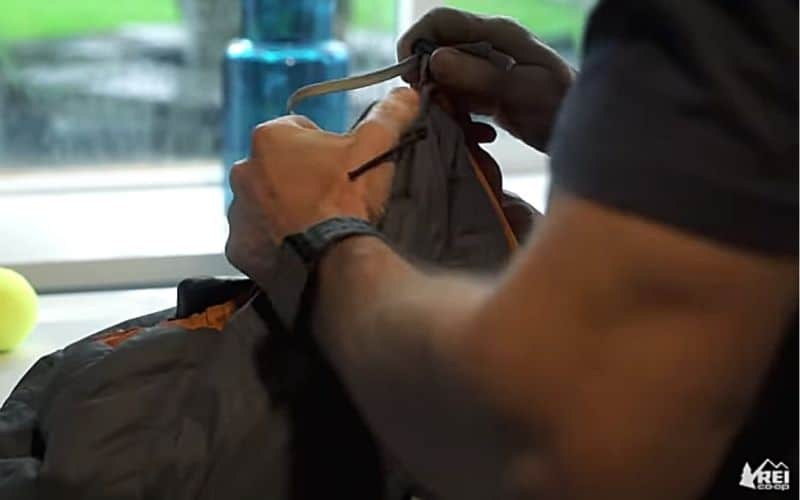
Once you’ve confirmed that your Coleman sleeping bag is safe to wash, you next want to prep the sleeping bag for washing by unzipping all the zippers and loosening up all drawcord.
As this will help prevent damage to the sleeping bag during the wash cycle.
In addition, if your Coleman sleeping bag has a hood, be sure to loosen or remove the hood drawstring as well.
Step 3: Load the Sleeping Bag into the Washing Machine
After you’ve prepped the sleeping bag, it’s time to actually load it into the washing machine.
When loading, be sure not to overload the washer, as this can damage both the washer and your sleeping bag.
As a general rule of thumb, it’s best to wash no more than one sleeping bag at a time in a standard-size front load washing machine.
It’s also best to wash your sleeping bag by itself.
Step 4: Choose the Right Wash Cycle and Water Temp
After you’ve loaded your Coleman sleeping bag into the washing machine, it’s time to actually start the wash cycle.
When choosing a wash cycle, choose the most gentle one that your washing machine offers and use either cold or warm water, never hot.
As hot water can actually damage the synthetic fabrics or down fill in your sleeping bag.
Step 5: Add Recommended Amount of Outdoor Gear Cleaner
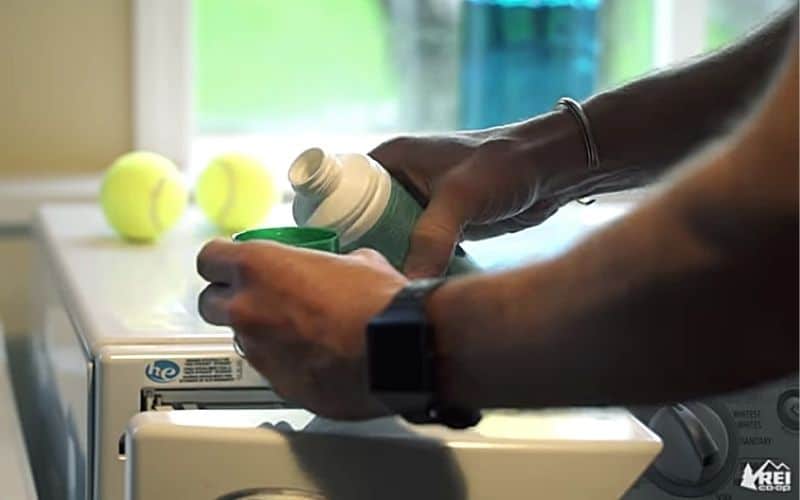
After you’ve chosen the right wash cycle and water temperature, it’s time to add the recommended amount of cleaner to the washing machine.
To do this, refer to the bottle on your outdoor gear cleaner to see how much to add.
Step 6: Let the Washing Machine Do Its Job
Now that the sleeping bag is loaded into the washing machine and the recommended amount of cleaner is added, simply let the washing machine do its job, which depending on your washing machine should take between 45 minutes to an hour for a full wash.
Step 7: Give the Sleeping Bag a Second Rinse Cycle
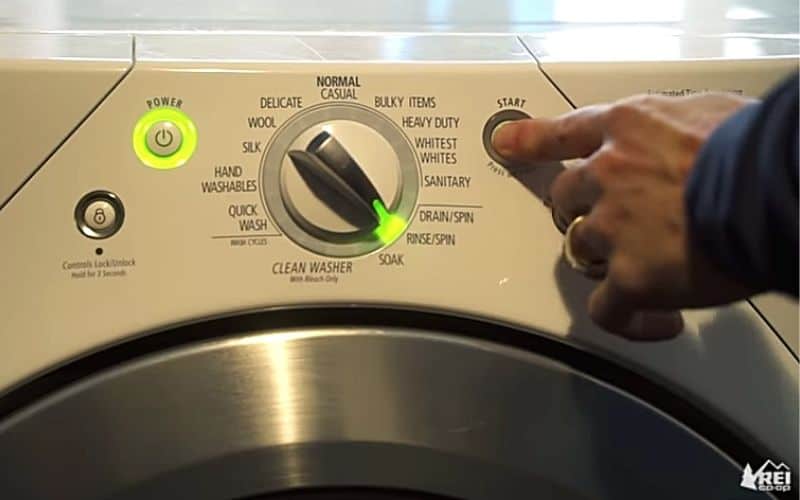
After the initial wash cycle has been completed, it’s generally a good idea to run a separate rinse cycle, just to be sure that all the cleaner is out of the sleeping bag.
And when running the second rinse cycle, once again use cold or warm water, never hot.
Step 8: Remove the Sleeping Bag from the Washer
Once the second rinse cycle has been completed, squeeze out any standing water and support the bag from below when you remove it from the washer.
As wet insulation inside the sleeping bag can be very heavy, heavy enough to actually tear the sleeping bag baffles if they’re not supported properly.
Step 9: Load the Sleeping Bag into the Dryer for Drying
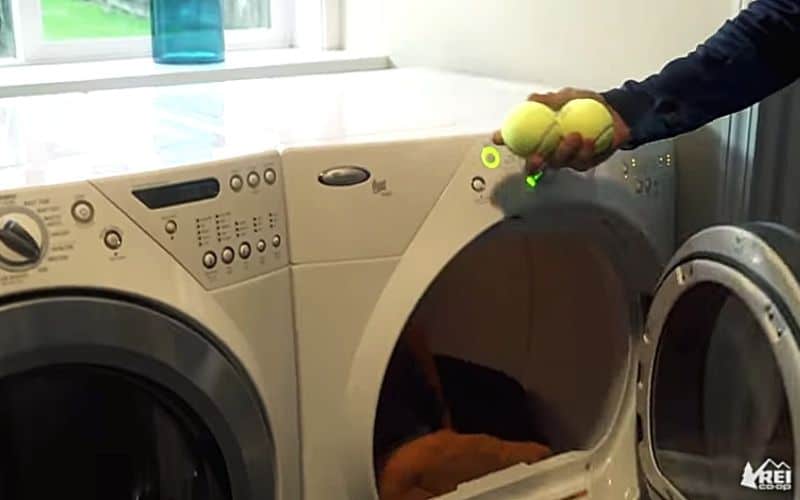
After you’ve removed the sleeping bag from the washer, it’s time to actually dry it.
When drying the sleeping bag, always make sure to use the lowest heat setting possible, and again it’s best to dry the sleeping bag by itself.
To help fluff up the sleeping bag as it’s drying, we recommend adding a couple of clean tennis balls into the dryer.
For most sleeping bags, it will usually take anywhere from one to two hours of drying on low heat to completely dry the bag.
This is one of the most dangerous steps when washing a sleeping bag, as any kind of high heat can damage and even ruin a sleeping bag.
So it’s a good idea to check on the sleeping bag every 15 minutes or so when drying, to ensure that you’re not overheating and potentially damaging the delicate fabrics found on sleeping bags.
Also, if you have the time, you might want to consider letting the sleeping bag air dry, just be prepared to wait several days if not longer.
Step 10: Lay the Sleeping Bag Out Overnight

To ensure the sleeping bag is completely dry after washing and drying, it’s best to lay the sleeping bag out overnight before storing it.
As rolling or folding up an even slightly damp sleeping bag can quickly lead to mold and mildew issues.
Top 9 Tips to Take Care of a Colemen Sleeping Bag
Now that you know how to safely and properly wash you’re Coleman sleeping bag, let’s take a quick look at a few other best care practices to ensure your Coleman sleeping bag stays in tip-top shape year after year.
Store the Sleeping Bag in a Dry Place When Not in Use
When storing your Coleman sleeping bag, it’s important to make sure that it’s stored in a dry place.
Sleeping bags can be particularly susceptible to moisture damage, so if you live in a humid climate or are planning on storing your sleeping bag for an extended period of time, consider using a moisture-resistant storage bag or container like this popular one on Amazon.
Keep the Sleeping Bag Away from Direct Sunlight
When storing your sleeping bag, it’s also important to keep it away from direct sunlight.
The ultraviolet (UV) rays of sunlight can damage the fabrics used in sleeping bags, so it’s best to store your sleeping bag in a dark closet or storage container.
Avoid Storing the Sleeping Bag Near Heat Sources
Another thing to avoid when storing your Coleman sleeping bag is heat sources.
As heat can damage the fabrics and insulation of a sleeping bag, so it’s best to store your sleeping bag in a cool, dry place.
Zip-Up the Sleeping Bag to Keep it Clean
When not in use, it’s a good idea to zip up your Coleman sleeping bag.
This will help to keep the sleeping bag clean and free of dirt and dust.
If the Sleeping Bag Gets Wet, Dry it as Soon as Possible
If your Coleman sleeping bag gets wet, it’s important to dry it as soon as possible.
Wet sleeping bags can mildew and mold, so it’s best to dry them as quickly as possible.
The best way to dry a wet sleeping bag is to air dry it in a well-ventilated area.
Use a Sleeping Bag Liner to Prolong the Life of the Sleeping Bag
A sleeping bag liner is a great way to prolong the life of your Coleman sleeping bag.
Sleeping bag liners help protect the inside of your sleeping bag from body oils and sweat, which can damage the fabrics and insulation over time.
There are a variety of different sleeping bag liners on the market, just be sure to choose one that’s made from a breathable fabric like cotton.
These are three favorite options:
- Tough Outdoor Store Sleeping Bag Liner
- Vumos Sleeping Bag Liner and Camping Sheet
- Sea to Summit Reactor Insulated Sleeping Bag Liner
Follow the Washing and Care Instructions that Come with the Sleeping Bag
To ensure your Coleman sleeping bag has a long life, it’s important to follow the washing and care instructions that come with it.
Coleman provides detailed care instructions on their website, so be sure to consult those before washing or storing your sleeping bag.
Only Wash the Sleeping Bag When Necessary
Washing your sleeping bag too often can damage the fabrics and insulation, so only wash it when necessary, ideally not more than once or twice per camping season.

FAQs
Yes, you can put a sleeping bag in a washing machine.
But it’s important to follow the sleeping bag’s washing and care instructions, use the gentle cycle for washing, low heat for drying, and a detergent specifically designed for outdoor gear, such as Nikwax Tech Wash.
Dry cleaning can damage the fabrics and insulation of a sleeping bag, so it’s not recommended.
If you need to have your sleeping bag professionally cleaned, look for a company that specializes in cleaning outdoor gear.
Washing a sleeping bag too often can damage the fabrics and insulation, so only wash it when necessary.
If you follow the washing and care instructions that come with your sleeping bag, then washing it shouldn’t ruin it.
You should only wash a sleeping bag when it’s necessary.
If the sleeping bag is extremely dirty or smells bad, then it’s time to wash it, it’s generally best not to wash a sleeping bag more than once or twice per camping season.
Wrap Up
With proper care, your Coleman sleeping bag will provide you with years of trouble-free comfortable camping.
Some of the best ways to care for a Coleman sleeping bag are to follow its specific wash and care instructions, only wash it when necessary, use the gentle cycle when washing, and low heat when drying.

